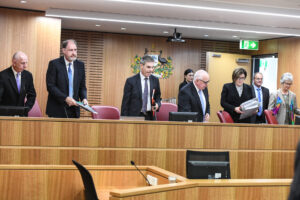Paying for Collective Bargaining

Recent labour law reforms in Australia have focused attention on the crucial role played by collective bargaining in achieving higher wages, safer working conditions, and better job security.
New provisions contained in both the Secure Jobs Better Pay (2022) and Closing Loopholes (2023) legislation will expand the scope for collective bargaining (including more opportunities for bargaining at a multi-employer level), make it harder for employers to evade collective bargaining, and empower union delegates to fulfil their responsibilities in workplaces to administer and enforce collective agreements.
However, one important challenge for Australia’s collective bargaining system, that has not been addressed by these reforms, is how to pay for collective bargaining. The infrastructure of representation, bargaining, implementation and enforcement requires ongoing commitment of people and resources, from both the union and the employer sides of the relationship.
In Australia at present, the workers’ side of this infrastructure is dependent on voluntary union dues contributed by individuals who choose to join a union in their industry. No collective system of union security or dues collection (such as closed or agency shop arrangements, dues preferences, or bargaining fees) are presently allowed under Australian law. Moreover, Australian law fully protects the ability of individual workers to ‘free ride’ on the benefits and protections negotiated by unions in their workplace: every provision of a collective agreement must be provided to all workers in a defined bargaining unit (whether they are members of the union that negotiated them or not). From a perspective of narrow self-interest, this system discourages union membership — and in turn starves the collective bargaining system of the resources it needs to be viable.
In this article published in The Conversation, Centre for Future Work Director Jim Stanford discusses the nature of this ‘free rider problem,’ and highlights how the treatment of this problem varies wildly between business and union applications. Legal contracts which enforce collective revenue solutions to free-rider problems are common and fully acceptable in many common applications: such as residential strata arrangements, the governance of joint stock corporations, and even government tax collections. Where unions are concerned, however, the law prevents workers from making and enforcing a collective decision to jointly fund the apparatus of collective bargaining, to the shared detriment of workers who consequently cannot exercise collective bargaining power to improve their employment relationship. The rhetoric of ‘individual choice’ is applied selectively to industrial relations; no owner of a strata unit, or shareholder in a corporation, has the ‘free choice’ to refuse to pay the normal costs and obligations associated with those arrangements.
Australia’s restrictions on union security and collective dues arrangements are uniquely restrictive among industrial countries; they are similar to the rules in so-called ‘right-to-work’ states in the U.S., where union representation has fallen to the low single digits. Free riding has been an important factor in the long-term erosion of union density in Australia: most recent data indicates that just 12.5% of employees in Australia are presently union members. Workers with greater awareness of the importance of collective bargaining to their long-term prosperity will support their unions, even though they are legally entitled to all the benefits of a collective agreement whether they join or not. But the current laws discourage this act of collective solidarity, and collective bargaining has been eroding accordingly. At present just 15% of workers in Australia are covered by an active enterprise agreement (and less than 10% in the private sector). The erosion of collective bargaining has contributed to wage stagnation, growing inequality, and job insecurity.
Dr Stanford’s Conversation article has been selected for inclusion in the new anthology, 2023: A Year of Consequence, published by Thames & Hudson, and edited by Justin Bergman (International Editor of The Conversation). The book contains several essays published by The Conversation in 2023 that are judged to have contributed most to public policy dialogue in Australia over the past year.
Further information on the extent and consequences of free riding in Australian collective bargaining, and five different strategies for addressing this problem (based on the variety of policies implemented in other industrial countries where collective bargaining is better-resourced, and hence stronger and more effective), are provided in Dr Stanford’s recent scholarly article in Labour and Industry, titled “International approaches to solving the ‘free rider’ problem in industrial relations.” Click below to see the full article.
Related documents
Related research
You might also like
Want to lift workers’ productivity? Let’s start with their bosses
Business representatives sit down today with government and others to talk about productivity. Who, according to those business representatives, will need to change the way they do things?
Feeling hopeless? You’re not alone. The untold story behind Australia’s plummeting standard of living
A new report on Australia’s standard of living has found that low real wages, underfunded public services and skyrocketing prices have left many families experiencing hardship and hopelessness.
The continuing irrelevance of minimum wages to future inflation
Minimum and award wages should grow by 5 to 9 per cent this year


